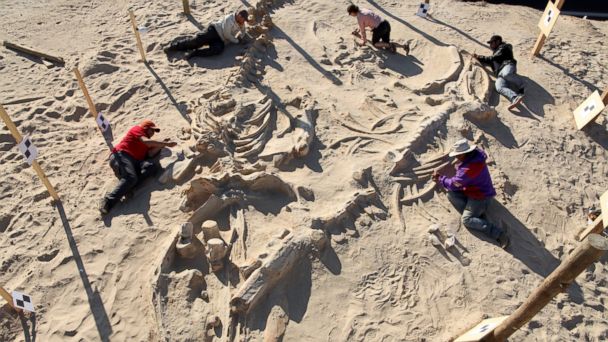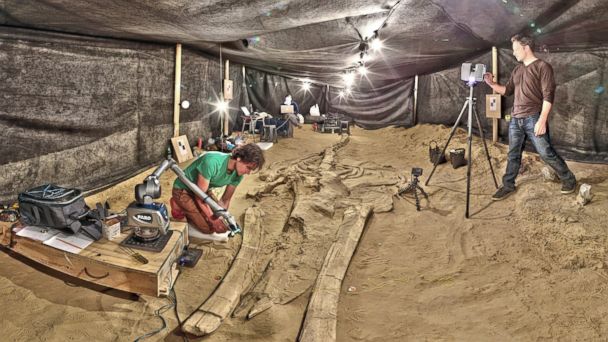Mystery of Whale Graveyard Solved
Scientists believe they have solved the mystery of a massive ancient whale graveyard and they believe the huge mammals were killed off by poisonous algae.
The skeletons of at least 40 whales along with numerous other sea creatures were discovered in 2010, but why they all ended up near a coastal highway in Chile was a puzzle.

A 3D model of fossil rorqual whales, from Cerro Ballena, in Chile, which overlap one another, including two adults and a juvenile. Smithsonian
Nicholas Pyenson of the Smithsonian's National Museum of Natural History has authored a study that points blame at a toxic algae that bloomed, killed the giant mammals quickly and had them float belly up onto the beach. The whales were determined to be laying on their backs, indicating they had not beached themselves, Pyenson concluded. They also apparently washed ashore quickly before they could be scavenged by other fish, like sharks.

Chilean and Smithsonian paleontologists study several fossil whale skeletons at Cerro Ballena, next to the Pan-American Highway in Atacama Region, Chile, in 2011. Smithsonian
"These big hunks of meat stranded on a tidal flat, yet there were no terrestrial predators like a bear, nothing really larger than a dog, that could dismember the carcasses and carry the bones away," Pyenson said.
The bones were found in an area known as Cerro Bellena, or Whale Hill.
The killer algae bloomed in the area repeatedly, killing of whales, seals, marlins and other fish that washed ashore over a period of 10,000 to 16,000 years, Pyenson said, and was believed to have taken place more than 5 million years ago.

On the far left and far right, Adam Metallo and Vince Rossi from the Smithsonian's Digitization Program Office 3D Lab, use high-resolution laser arm and medium-range laser scanners to document one of the most complete fossil whales from Cerro Ballena in 2011. Smithsonian
Pyenson told ABC News that the find at Cerro Ballena is remarkable. "We have recovered a striking diversity of marine organisms, that gives us a window into ocean food webs in the geologic past," he said.
"Everything we found is an extinct species, but that doesn't mean you can't identify what they are," he said. For instance, the whales would somewhat resemble the blue whales of today.
The 40 whale skeletons are just the beginning, he said. "We know that for a fact that there are going to be more whales discovered-estimate hundreds of skeletons to be found," he said.